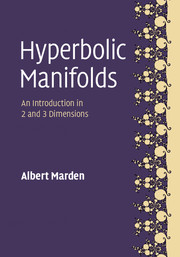Book contents
- Frontmatter
- Dedication
- Contents
- List of Illustrations
- Preface
- 1 Hyperbolic space and its isometries
- 2 Discrete groups
- 3 Properties of hyperbolic manifolds
- 4 Algebraic and geometric convergence
- 5 Deformation spaces and the ends of manifolds
- 6 Hyperbolization
- 7 Line geometry
- 8 Right hexagons and hyperbolic trigonometry
- Bibliography
- Index
2 - Discrete groups
Published online by Cambridge University Press: 05 January 2016
- Frontmatter
- Dedication
- Contents
- List of Illustrations
- Preface
- 1 Hyperbolic space and its isometries
- 2 Discrete groups
- 3 Properties of hyperbolic manifolds
- 4 Algebraic and geometric convergence
- 5 Deformation spaces and the ends of manifolds
- 6 Hyperbolization
- 7 Line geometry
- 8 Right hexagons and hyperbolic trigonometry
- Bibliography
- Index
Summary
This chapter introduces the related notions of discreteness and discontinuity, limit set and ordinary set. We establish the connection between discrete groups of Möbius transformations and hyperbolic manifolds and orbifolds. Some classical special cases of discrete groups are presented: elementary groups (which we classify), fuchsian and Schottky groups. The chapter includes crash courses on covering surfaces, Riemann surfaces, and quasiconformal mappings. The first two of these topics help us understand the boundaries of the 3-manifolds, while the latter shows us how to make controlled deformations of them. Along the way we introduce the Uniformization Theorem, Teichmüller spaces, and mapping class groups.
Convergence of Möbius transformations
Proposition 2.1.1 (General convergence theorem). Suppose {Tn} is an infinite sequence of distinct Möbius transformations such that the corresponding fixed point(s) pn, qn converge to p, q ∈ s2; here either pn = qn, or Tn is elliptic, or pn is the repelling and qn the attracting fixed point of Tn. There is a subsequence {Tk} with one of the following properties.
(i) There exists a Möbius transformation T such that lim Tk(z) = T(z) uniformly on ℍ3 ∪ s2(considered with the euclidean metric), or equivalently, Tk → T for suitable choices of the associated matrices.
(ii) lim Tk(z) = q for all z ≠ p, uniformly on compact subsets of ℍ3∪(s2\{p}). Also lim Tk−1(z) = p for all z ≠ q, uniformly on compact subsets of ℍ3 ∪ (s2 \ {q}). Possibly p = q.
Examples: {z + n}, {kn z}, {ei/n z}, {a2z + (n1 − a2)}.
Before proving the lemma, we state as a corollary a stronger form of Montel's theorem on “normal families” (the original requires three omitted values).
Corollary 2.1.2.Suppose {Tn} is an infinite sequence of distinct Möbius transformations and U ⊂ s2 is a connected open set. Suppose there are two distinct points ζ1, ζ2 in s2 such that Tn(U) avoids ζ1 and ζ2, for all n. Then there is an infinite subsequence {Tm} which converges on U, uniformly on compact subsets, to a Möbius transformation or to a constant.
- Type
- Chapter
- Information
- Hyperbolic ManifoldsAn Introduction in 2 and 3 Dimensions, pp. 53 - 121Publisher: Cambridge University PressPrint publication year: 2016



